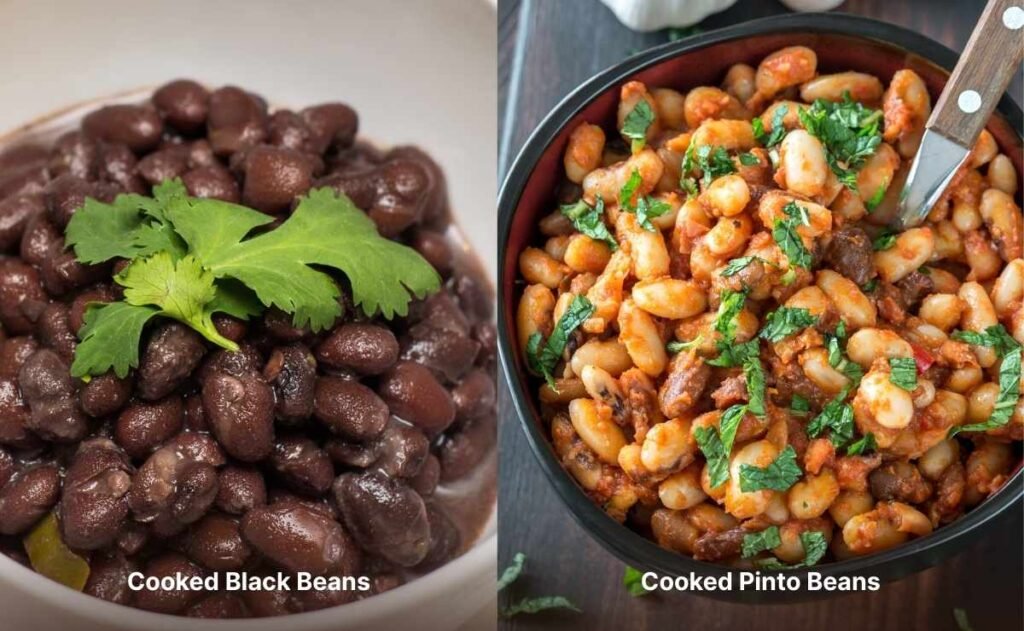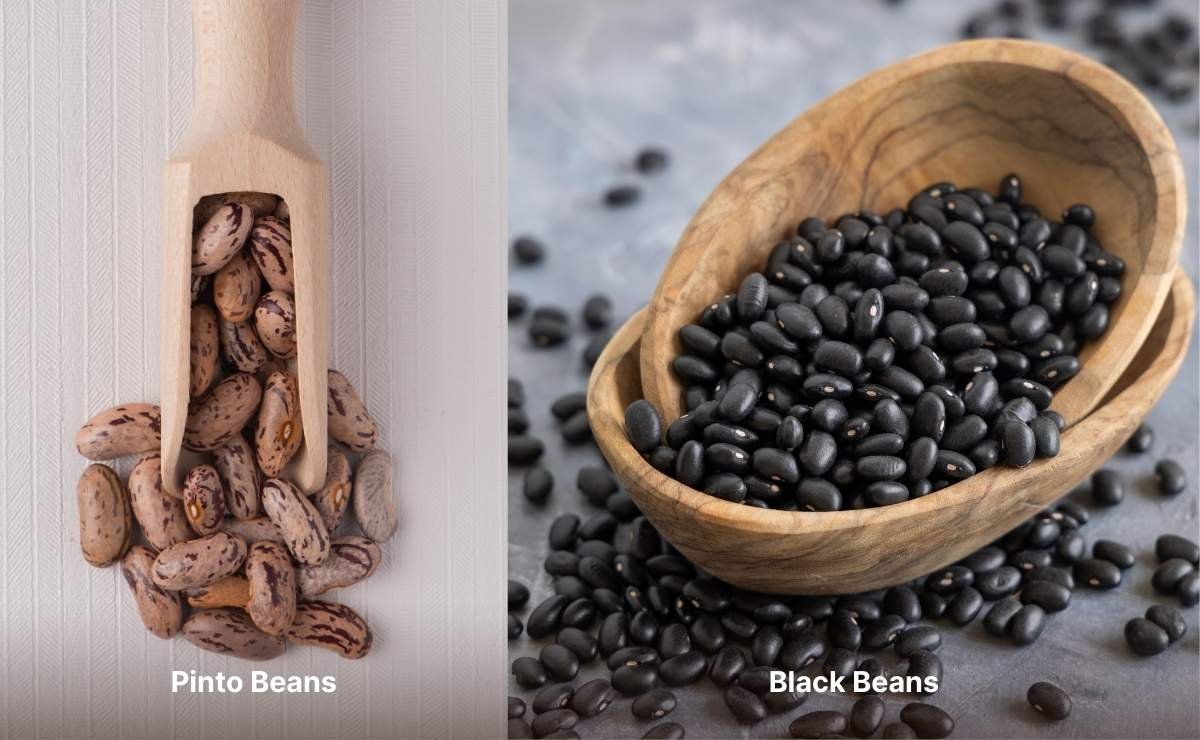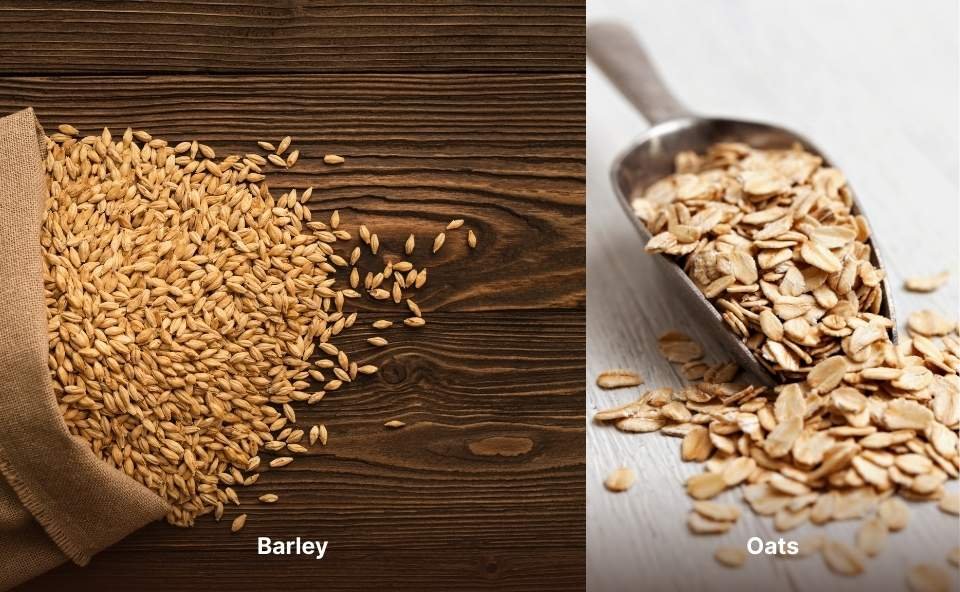Black beans and pinto beans are two of the most popular legumes, but when it comes to nutrition, taste, and versatility, each shines in its own way.
This guide dives into the ultimate showdown: Black Beans vs Pinto Beans — which one deserves a spot in your next meal?
I still remember the first time I cooked black and pinto beans—the kitchen filled with rich aromas. From that moment, these humble legumes became my go-to for hearty, nutritious meals. In the US, especially in Latin and American homes, these staples are more than just food—they’re culture, comfort, and full of health benefits.
Over the years, I’ve experimented with dry, canned, and even lentils, mung, and chickpeas, but black and pinto always stood out. While pinto beans are common and creamy, black beans have a bold flavor that I love. Both are packed with protein, fiber, and nutrition and fit easily into different diets, from tacos to salads.
Before diving into the showdown, let’s take a moment to get to know each of these beans better.
🫘Getting to Know Black Beans
When I began my plant-based journey, black beans kept popping up—whether in soups, burritos, burgers, or dips—and I quickly understood why. These small, dark gems offer a mild, versatile flavor that blends beautifully into Tex-Mex, Latin American, and Caribbean dishes. Known as black turtle beans, Tampico beans, and even turtle beans (thanks to their shiny, hard shell like a turtle shell), they’ve been a staple in South America for over 7,000 years.
Native to Mexico and cultivated in Central America, these legumes—common beans or Phaseolus vulgaris—remain prevalent in Mexican, Brazilian, and Cuban cooking. I’ve loved experimenting with them in classic favorites like Cuban bean rice, Brazilian black bean stew, and creole recipes from South Louisiana.
With the rise of plant-based eating in the United States, they’ve become my favorite meat substitute, and I now see them as a deeply rooted cultural food, known by names like frijoles negros and caviar criolla.
If you’re curious about how black beans compare to other popular beans, check out our detailed comparisons of Black Beans vs Pinto Beans and Black Beans vs Kidney Beans for more insights on these nutritious options!
🫘Getting to Know Pinto Beans
When I think of Pinto beans, I immediately picture tacos, burritos, and that comforting bowl of chili. With their mottled skin and painted look, these beans are a staple in Southwestern American and Latin American dishes. Native to Mexico and Peru, they’ve been cultivated for 6,000 years, showing their deep-rooted history. From Tex-Mex to American recipes, Pinto beans have earned their place in kitchens worldwide.
What I love most about pinto beans is how versatile they are. Whether mashed, in soups or paired with rice, they’ve been a comfort food in many homes, including my own. Pinto beans, known as frijoles pintos in Spanish, have become a go-to meal in many American and Latin American cuisines. With their attractive patterns and the ability to turn uniformly pink when cooked, they’re a beautiful and delicious addition to any dish.
If you want to dive deeper, don’t miss our Pinto Beans Complete Guide to explore everything about them!
Additionally, if you’re wondering how pinto beans compare to other favorites, check out our easy guides on Kidney Beans vs Pinto Beans, Navy Beans vs Pinto Beans, and Great Northern Beans vs Pinto Beans to find your perfect match!
Now that we’ve explored what makes each one special, let’s put them side by side and see who stands out!
🎨Appearance
When cooking black and pinto beans, their different looks always catch my eye. Black beans are smaller, oval, and shaped like peas, with deep black skins that retain their bold color after being cooked, while their insides stay white and creamy.
On the other hand, Pinto beans start with a speckled appearance, mixing brown and white like a Pinto horse — fitting since “Pinto” means painted in Spanish. Once cooked, their speckling melts into a solid caramel color, with a soft pinkish hint that shows off their mottled beauty.

Cooked black beans and pinto beans side-by-side highlighting texture and color after cooking.
No matter the size or bean, they each bring charm to a perfect legume dish.
🥄Taste and Texture
Black beans have a rich, earthy flavor with a slightly sweet note. Their smooth, creamy texture makes them a great meat substitute in vegan recipes.
On the other hand, pinto beans have a more nutty, subtle flavor with an extra earthiness that shines when cooked with chilis, garlic, cumin, and onion. Their texture is soft and creamy, perfect for soups or stews.
💪Nutrition and Health Benefits
Black beans and pinto beans are true superstars when it comes to boosting your health through food. Let’s take a closer look at their powerful nutrition profiles and the unique health benefits they bring to your plate!
Please note: All nutrition facts mentioned here are based on cooked black beans and pinto beans, making it easy to relate to what you actually eat in a regular meal!
- Plant-Based Protein Power: Both black beans and pinto beans are fantastic sources of plant-based protein, making them a must for anyone looking to boost daily intake. Black beans offer about 15g of protein per cup, while pinto beans provide 15g, helping you feel full and energized after meals.
- Fiber for Digestive Health: From personal experience, both beans are fiber champions! Black beans deliver about 15g of fiber per cooked cup, and pinto beans contain about 15g of fiber, supporting digestive system function, weight loss, and overall gut health.
- Heart Health Heroes: Regularly enjoying black or pinto beans can help lower blood pressure, reduce total cholesterol, and even decrease LDL cholesterol levels. Their fiber, potassium, and low sodium profile make them heart-smart choices, perfect for supporting cardiovascular wellness.
- Antioxidants and Anti-Inflammation Boost: Black beans, with their dark, rich color, are loaded with antioxidants that fight oxidative stress and reduce inflammation. Pinto beans, on the other hand, offer a nutrient punch that helps promote cell protection and overall vitality.
- Complete Protein with Grains: Pairing black beans or pinto beans with grains like rice, barley, wheat, or corn creates a complete protein that delivers all nine essential amino acids—something I always recommend for a balanced vegan or vegetarian diet.
- B-Vitamins and Nerve Health: Pinto beans are especially rich in B-complex vitamins like B1 and B9 (folate), which are essential for nerve health, blood health, and bone strength. Adding them to your meals feels like a small, easy way to protect your body’s core systems.
- Blood Sugar and Energy Support: Thanks to their low glycemic index, black beans help regulate blood sugar levels and provide sustained energy throughout the day. They are an excellent option for balancing meals, especially for managing appetite and mood swings.
- Low-Sodium, Low-Fat Goodness: Both black and pinto beans are naturally low in fat (around 1g per cup) and can be easily made low-sodium by rinsing canned versions—a simple step that helps create delicious, healthier recipes.
- A Fiber-Rich American Favorite: According to the NIH, beans are one of America’s most consumed fiber foods. They help lower the risk of heart disease, stroke, type 2 diabetes, and high blood pressure. Just one serving gets you halfway to your daily fiber goal—amazing for such a humble ingredient!
✅ Sources:
⏳Cooking Time
In the U.S., it’s easy to grab canned black beans or pinto beans at the store. But starting with dried beans is worth it if you want that authentic homemade flavor. You get complete control over salt, skip preservatives, and enjoy a fresher, richer taste. You only need water, heat, and simple tools like an Instant Pot, pressure cooker, stovetop, or slow cooker.
From my kitchen experiments, how you cook your beans seriously affects their flavor and texture. Knowing when to add salt makes a huge difference, too — it helps create that perfect creamy bite. Cooking dried beans isn’t hard — just a little time, patience, and a few easy tips you’ll pick up along the way.
Pinto Beans 🫘
- Pressure Cooker (Unsoaked): 50 minutes
- Pressure Cooker (Soaked): 15 minutes
- Stove Top: About 2 hours and 30 minutes
- Slow Cooker: Around 8 hours
Black Beans 🖤
- Pressure Cooker (Unsoaked): 25-30 minutes
- Pressure Cooker (Soaked): 10 minutes
- Stove Top: About 1 hour and 30 minutes
- Slow Cooker: Around 8 hours
🛒Price Check
Regarding cost, black beans and pinto beans are both super budget-friendly, but there are slight differences. Back in March 2024, I spotted black beans at Walmart for around $1.48lb, while pinto beans were cheaper at $1.24 per pound. Things get even better at WinCo — black beans were just 98 cents/pound and pinto beans about 78 cents/pound in their bulk bins, which saves me money when I’m stocking up.
As of April 2025, prices are still excellent: you can grab pinto beans (20 lb) for $16.47 or a smaller 4 lb bag for $3.76 at Walmart, and black beans (4 lb) for $4.88. I love that even a 15-oz can of black beans is just $0.94 — perfect for quick dinners.
🍛Tasty Recipes You’ll Love
Pinto Beans
Pinto beans are a must-have in my kitchen for so many cozy dishes from Mexican cuisine and all over Latin America, South America, and Central America. Their creamy texture is perfect for traditional dishes like refried beans and hearty soups. I have some authentic favorite recipes using this humble type of bean, and every bite reminds me why beans are loved worldwide.
- Instant Pot Borracho Beans Recipe (Pinto Beans)
Bold, hearty, and packed with Tex-Mex flavor, these Instant Pot Borracho Beans are the ultimate easy side or main dish — made with pinto beans, smoky bacon, and a splash of beer.
A flavorful one-pot dish where pinto beans are simmered with onion, tomatoes, chili powder, cumin, and garlic.
An old-fashioned recipe where dry pinto beans are cooked in a flavorful broth with onion, green chili salsa, jalapeño, and cumin.
A simple and fast recipe for refried beans made with pinto beans, garlic, spices, and lime—ready in just 20 minutes.
Black Beans
Black beans bring a richer flavor that I reach for when making salads, tacos, and vibrant bowls. They’re a huge part of traditional dishes across South America, Central America, and Latin America. I love how they add texture and boldness to a meal. Some of my favorite recipes truly highlight the magic of this type of bean, showing again why beans are a staple loved worldwide.
Smoky, hearty, and perfectly seasoned, these Chipotle-style black beans are a quick, cozy, and flavorful favorite for any meal.
Instant Pot Black Beans – a quick, healthy, no-soak recipe packed with bold flavor and ready in under an hour!
A traditional Cuban dish featuring black beans simmered with onions, bell peppers, garlic, and spices for a flavorful side.
A healthy, low-fat salad made with black beans, onions, tomatoes, bell peppers, corn, and a zesty dressing.
A wholesome, budget-friendly vegetarian meal combining black beans and rice, seasoned with garlic, cumin, and cayenne pepper.
❓Frequently Asked Questions
Which is healthier: Black Beans or Pinto Beans?
Honestly, you can’t go wrong with either! Both are packed with fiber, plant-based protein, and vitamins. Black beans have slightly more fiber and protein, but the difference is tiny. Whichever you pick, your body will thank you.
Can I substitute one for the other in recipes?
Absolutely! Their texture and flavor are so similar that swapping black beans for pinto beans (or vice versa) works in almost any dish. Just keep in mind that black beans are dark, while pinto beans are lighter with pinkish-beige spots—color might matter for presentation.
Which has more protein?
Black beans win by just a gram—about 16g per cup vs. 15g for pinto beans. Pair them with grains like rice or corn for a complete protein boost!
Are there digestive differences?
Both black beans and pinto beans are packed with fiber, which is excellent for digestion, blood sugar, and heart health. But here’s a heads up: Too much fiber too fast can cause gas and bloating! Beans also have natural sugars (oligosaccharides) that some people, especially those with IBS, find harder to digest. Start small and increase slowly—you’ll feel a lot better!
Which one tastes better?
Depends on your vibe! I love pinto beans for their creamy, mild flavor (perfect for mashable fillings). Black beans have a deeper, meatier taste and hold their shape, making them salad superstars.
Do black beans and pinto beans cook differently?
Yep! Pinto beans break down easily, perfect for creamy dishes and spreads. Black beans stay firmer, which is ideal for soups and salads where you want visible beans.
How much should I eat?
Start with ½ cup servings to keep your gut happy. You can go bigger in dishes like black bean soup or chili—ease into it!
🔚Final Thoughts
Black and pinto beans are packed with plant-based protein, fiber, and essential nutrients—great for heart health, digestion, and lasting energy. While both are versatile and budget-friendly, black beans win with more antioxidants, protein, and bold flavor.
That said, it really comes down to what you’re looking for!

Hi, I’m the voice behind The Bean Bite — someone who’s genuinely obsessed with beans! What started as a simple love for homemade lentil stew turned into a journey of discovering bean varieties, cooking tips, and their amazing health benefits. This site is my way of sharing that joy with you — one bean at a time.




Can you pressure cook both together?
And what about the 15 bean mix?
Yes, you can pressure-cook both ingredients together successfully. Ensure the beans are soaked overnight or given a quick soak to promote even cooking and reduce pressure time.
When using a 15-bean mix, rinse thoroughly and discard any seasoning packet (if included) unless your recipe specifically calls for it. For optimal results, cook on high pressure for 25–30 minutes, followed by a natural pressure release. This method ensures that the beans and accompanying ingredients have the ideal texture and flavor.